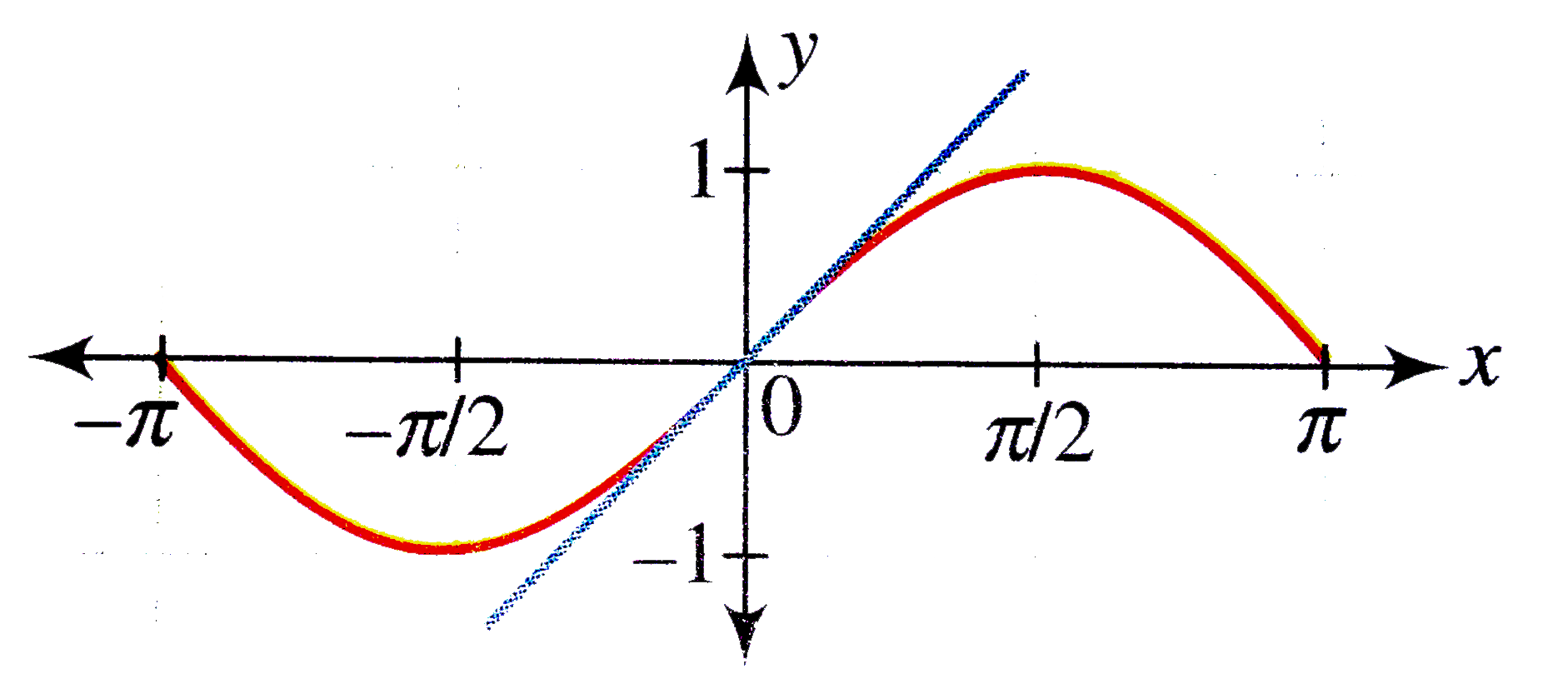Evaluate : , where represents the greatest integer function.Solution in Bengali
Let us first draw the graphs of y = x and y = sin x.
For y = x, y' = 1, i.e. the slope of line is 1 for all real x.
For y = sin x, y' = cos x.
Thus, both y = x and y = sin x have slope '1' at x = 0, hence the graphs touch each other at x = 0.
Moving from '0' to , the values of cos x decrease from '1' to '0'.
Thus, the graph of y = sin x lies below the graph of y = x.
The graphs of y = x and y = sin x are plotted as follows.

From the graph, when , as the graph of y = x is above the graph of y = sin x,
When , as the graph of y = x is below the graph of y = sin x,
(as x is negative)
Thus,
Topper's Solved these Questions
- BOOK - CENGAGE PUBLICATIONCHAPTER - GRAPHS OF TRIGONOMETRIC FUNCTIONSEXERCISE - Exercises22videos
GRAPHS OF TRIGONOMETRIC FUNCTIONS
- BOOK - CENGAGE PUBLICATIONCHAPTER - GRAPHS OF ELEMENTARY FUNCTIONS EXERCISE - EXERCISES34videos
GRAPHS OF ELEMENTARY FUNCTIONS
- BOOK - CENGAGE PUBLICATIONCHAPTER - HIGHT AND DISTANCE EXERCISE - Archives3videos
HIGHT AND DISTANCE
Similar Questions
Draw the graph of y= cosec 2x−cot2x. Is f(x) periodic ? If yes, what is its fundamental period ?
06:15View SolutionDraw the graph of y=1(1/x).
03:37View SolutionA bird is sitting on the top of a vertical pole 20 m high and its elevation from a point O on the ground is 45o . It flies off horizontally straight away from the point O. After one second, the elevation of the bird from O is reduced to 30o . Then the speed (in m/s) of the bird is (1) 40(√2−1) (2) 40(√3−2) (3) 20√2 (4) 20(√3−1)
03:17View SolutionEvaluate: (lim)x→0sinxx,where[.] represents the greatest integer function.
02:45View SolutionEvaluate (lim)x−→5π4 [sinx+cosx], where [.] denotes the greatest integer function.
02:15View SolutionThe value of lim_(x rarr0)[(sin x)/(x)] is (where [.] denotes greatest integer function)
03:28View SolutionIf f(x)=(sin(1+[x]))/([x]) for x!=0 (where [.] represents the greatest integer <=x), then lim_(x rarr0^(-))f(x) equals
05:20View Solutionlim_(x rarr0)|x(x-1)|^([cos2x]), where [^(*)] represents the greatest integer function,is equal to
03:16View Solutionlim_(x rarr0)(tan^(2)[x])/([x]^(2)), where [] represents greatest integer function,is
01:33View Solutionlim_(x -> 0)[sin[x-3]/([x-3])] where [.] denotes greatest integer function is
01:13View SolutionEvaluate : [limx→0sinxx], where [⋅] represents the greatest integer function.
View SolutionThe value of limx→0[xsinx] , where [.] represents the greatest integer function,is
13:43View Solutionlimx→0[100tanxsinxx2] is (where [.] represents greatest integer function).
03:38View SolutionValue of limx→0−[sin[x]x]+limx→0+[sin−1|x||x|]+limx→0−[−2xtanx] is (where [.] denotes greatest integer function)
02:03View Solutionlimx→0[99tanxsinxx2]= Where [.] denotes the greatest integer function
02:09View Solutionlimx→0|x|[cosx] जहाँ [⋅] महत्तम पूर्णांक फलन है, का मान है
02:04View Solution

